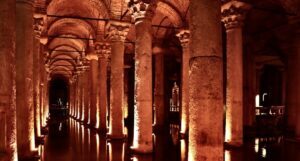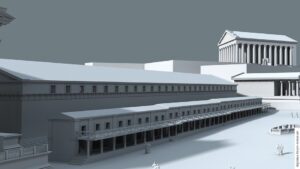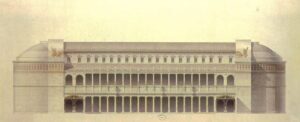
To most people today the word “basilica” suggests a Christian church of great splendor, such as St. Peter’s in the Vatican. To the ancient Greeks, however, the term meant “…a kingly and spaciously beautiful hall”; to their conquerors, the Romans, a courthouse. In the floor plan of such a building, the latter saw an ideal setting for the administration of justice.
Generally it was a large, imposing, rectangular structure whose width was anywhere from one half to one third of its length. Customarily, the interior of a Greek basilica consisted of, among other features, a wide center aisle flanked with Doric columns separating it from two narrower side aisles, and, in one of the end walls, a curved semi-domed recess (apse) which housed the throne of the basileus {the Greek word for king).
The Romans gave the center aisle (called the “nave,” from the Latin word navis) higher walls and consequently, a higher ceiling than the rest of the building. These high walls, called the “clerestory” (sometimes spelled “clearstory” because of the illumination they provided) were usually veneered with marble and fitted with a line of windows that flooded the vast hall with daylight. A two-tiered portico served as the formal entrance. All this and much more we learn from the first century B.C. Roman writer, Vitruvius, in his book, De Architectura.

The basilica concept. Ulamm, Creative Commons Attribution-Share Alike 3.0 Unported, Wikimedia Commons
In a Roman basilica the space in the apse was taken up by an elevated platform that served as the tribunal’s bench. When the Christians of 4th century A.D. Rome began to raise magnificent churches, they, too, settled on the basilican design, using the apse for the sanctuary and main altar. In naming these houses of worship, they retained the word basilica since its original significance – Hall of the King – was altogether fitting in that it could now be taken as a reference to Christ as their King of Kings.
Returning to the 2nd century B.C., we know that this was a time when an intensive interest in monumental architecture studded the Roman world with aqueducts, bridges, arches, theaters, stadia, and many public buildings. It was during this time that the basilica began to be an integral part of the Eternal City’s landscape. As many as 17 modest-sized court complexes were scattered throughout town.
In the year 184 B.C., the censor Marcus Porcius Cato undertook an extensive and expensive building project in the Forum Romanum that included the construction of a large public assembly hall to be used also for juridical affairs. The historian Livy reports that despite vehement opposition in the Senate to this extravagant plan, the new facility went up and was named in honor of its sponsor:
“Cato…basilicam ibi fecit quae Porcia appellata est.”
(Cato erected a basilica there which was named The Basilica Porcia)
Then just five years later, the censor Marcus Aemilius Lepidus pushed through a bill that called for another Forum courthouse of even greater grandeur, the Basilica Aemilia, 322 feet in length, 98 in width, and over 100 in height. While it served at times as a conference hall for commerce and business transactions as well as for civic gatherings, its main purpose was to host major trials.
The year 169 B.C. saw yet another court building rise in the Forum, the Basilica Sempronia, named for Tiberius Sempronius Gracchus, father of the heroic Gracchi brothers Tiberius and Gaius, champions of the poor and downtrodden, both eventually martyred for the cause.
And in 121 B.C., with Roman society becoming increasingly litigious, up went the Basilica Opimia to help ease the backlog of cases to be adjudicated. While no trace of this basilica remains, it is thought to have stood near the Temple of Concord at the northern end of the Forum.
These four courthouses in the Forum Romanum (or Forum Magnum as it was also known) soon became a prominent part of daily life in the capital, not only for the legal crowd but also the general population. Open from sun-up to sun-down, these spacious halls – much cooler with their marble walls and pavements and lofty ceilings – served like air-conditioned retreats for all social classes on sultry days and as shelters on stormy ones. The lower classes could also combat the ennui of their underprivileged existence by attending the raucous trials of the rich and famous, with their professional, and paid, applauders, booers, and hissers always ready to perform on cue. Educated Romans had a voracious appetite for scandal and oratorical excellence and would sit, spellbound and crammed together, through long-winded testimony and presentations of evidence. (Martial wrote satires on windbag lawyers.)
One newcomer to the bar tells of his first experience with a jam-packed, turbulent courtroom:
“Being late for the trial, the crowd was so great that I could not get to my place without crossing the tribunal where the judges sat. And then I have this “pleasing” circumstance to add further, that a young nobleman, having had his tunic torn, an ordinary occurrence in a mob scene, stood, with his gown thrown over him, just to hear me for the full seven hours I was speaking, though my success in the case more than counterbalanced the fatigue of so long a speech.”
When court was not in session, the tribunes, elected representatives of the plebeians, often used the basilicas to hold meetings of their restless constituency, at which they reported on the latest goings-on in the Senate. Businessmen preferred to conduct their deals in the airy ambience of the basilicas, while the money changers set up shop in the shady confines of the porticoed entrances.
In the year 80 B.C. it was most likely that in the venerable, by now century-old Basilica Aemilia a young (26) handsome man from Arpinum, a humble hilltop village 70 miles south of Rome, launched a career that would propel him to great heights in the legal profession and the political world, ultimately sweeping him into the Presidency, i.e. the Consulship, of the Roman Republic. He agreed to be the defense counsel in the celebrated Sextus Roscius murder case, a role the whole Roman bar membership avoided like the proverbial plague because it would incur the wrath of the then all powerful ruthless dictator Sulla since a favored partisan of his had brought the charges. Against a stacked deck – corrupt judges, bribed jurors, a cunning silver- tongued prosecutor – this courageous novus homo (Latin for: the new man in town), in front of an overflow crowd, won the case. That night, Marcus Tullius Cicero was the talk of all the lavish dinner parties in the great houses on the fashionable Palatine Hill. Outside the court building, throngs had gathered to await the announcement of the verdict. A circus atmosphere prevailed: street vendors hawked their sundry wares, unemployed lawyers trolled the grounds for prospective clients, juvenile hoodlums sought to pick pockets, fights broke out between rooters of opposing sides. Roman troops ultimately cleared the Forum and restored order.
Before long the Basilica Aemilia began to show its age and a massive restoration effort was begun by the descendants of the founder, Marcus Aemiliuis Lepidus. Cicero, in a rambling newsy letter to his friend and confident Atticus, writes about the status of the restoration:
“In medio Foro basilicam iam paene texerat isdem antiquis columnis…”
(He had by now just about roofed his basilica in the middle of the Forum using the same ancient pillars.)
He also comments on the splendor of the renovated interior and the sums of money lavished on it. A century and a half later, Pliny the Younger maintained that the Aemilian Courthouse, with its statue-bedecked arcades, still ranked among the empire’s most beautiful and inspiring edifices. Sadly, the Aemilia was destroyed by Alaric and his Visigoths in the raid of A.D. 410. Today, the ruins are rather skimpy, with just some stubs of columns and parts of the brick portico denuded of their marble veneer, though most of the floor remains. In the nave there are traces of Alaric’s arson: small round raised green stains from coins – dropped by the money changers in their hasty flight and fused into the white stone pavement.
In the mid-first century B.C., during the ambitious dictatorship of Gaius Julius Caesar, who put an end to the Republic, the Sempronian Basilica was plowed under to make way for the grandiose Basilica Julia, named for the ruler. With its gleaming marble exterior and its two-storied arcaded entrance, the Julian venue quickly took over as the high court of appeals and the architectural focal point of the great public square. The interior consisted of a nave with two side aisles making a total width of 70 feet and a length of 269. There were plush cushioned curule chairs for dignitaries and not very comfy wooden bleachers for hoi polloi. Suetonius, in his magnum opus, “The Lives of the Twelve Caesars”, relates how, one day, the batty Emperor Caligula (A.D. 37-41) – seeking to draw attention to his “magnanimity” – stood on the roof of the Basilica Julia and, for hours, tossed money down on his “lucky” subjects while laughing uncontrollably at the mad scramble down below. Flavius Josephus, the Jewish historian, also mentions this stately structure.
_______________________________

Digital reconstruction of the Basilica Sempronia. Prof. Dr. Susanne Muth, Creative Commons Attribution-Share Alike 2.5 Generic, Wikimedia Commons
_______________________________
No new courthouse was erected in Rome until the reign of Trajan (Marcus Ulpius Trajanus), A.D. 98-117. This creative giant gave his imperial capital a state-of-the-art civic center that included a sprawling shopping mall, two well-stocked libraries – one Greek and one Latin – and a spanking new, first rate court complex, the Basilica Ulpia, the largest of them all, with four side aisles and two apses. His successor Hadrian (117-138) built the Basilica of Neptune. In the years 145-150, Manlius Publius Hilarus, a wealthy, civic-minded pearl merchant, gifted the city with a fine facility near the Coelian Hill, the Basilica Hilariana.
_______________________________

Reconstruction of Basilica Ulpia in Rome. Public Domain, Wikimedia Commons
_______________________________
Two more centuries would elapse before yet another basilica graced the Forum, an immense structure begun by Maxentius (A.D. 306-312) but completed by his successor Constantine in 313, who named it after himself. Most classical scholars and historians ever since, however, have preferred to call the building, Basilica Maxentia. Built on a cement platform, this most majestic and vast hall of three naves measured 328 feet in length, 213 in width. Its beautifully coffered and vaulted ceiling looked down at judges, jurors, and just plain folks from a vantage point of 118 feet. Five arched entrances faced the southern stretch of the Via Sacra. A graceful staircase conducted the visitor into the narthex with its depth of 27 feet, then into the great hall resplendent with polychrome marble walls and dazzling white pilasters. On the apse at the end of the central nave stood a colossus of the Emperor Constantine, the head, one arm with bulging bicep, and one foot of which survive and can be seen today in the courtyard of the Palazzo dei Conservatori, part of the Capitoline Museums. Of the eight, 45-foot-tall corinthian columns that once supported the upper walls of the center aisle, only one remains, but not in situ. Pope Paul V, of the wealthy Borghese clan, transferred it to the piazza in front of the Basilica of Santa Maria Maggiore, on the summit of the Esquiline Hill, where it holds aloft a travertine statue of the Virgin Mary sharply outlined against the limpid blue of a Roman sky. (An earlier Pope, Honorius I, had the gilded bronze tiles of the roof removed, to be used on the old St. Peter’s.)
The enormous Maxentian court remained mostly intact despite the barbarian invasions of the early Middle Ages, but the earthquake of the year 841 saw the collapse of the central nave. From then on, the ruins became a convenient quarry of marble for the prominent families of Rome. What survived this greedy assault on the structure and what we still see in our day were the three soaring coffered arches of the right nave. The still vast remains were enough to serve as a hall for horse shows and an equestrian school in the era of the Renaissance.
________________________________

Remains of the Basilica of Maxentius and Constantine in Rome. Public Domain, Wikimedia Commons
________________________________
Sadly, for lovers of things Classical, most of these elegant ancient courthouses have either vanished without a trace, or lie in extremely fragmented ruins. Of the Basilica Porcia and the Opimia, not a single identifiable stone is left. The Aemilia has left us just a few remnants of its former glory, as alluded to earlier. The skeletal remains of the Julian Court are outlined against the slopes of the Palatine and shadowed by the front colonnade of the Temple of Saturn. Trajan’s proud Basilica Ulpia offers even skimpier remains at the entrance to his time-gutted shopping mall.
Despite such devastation, there are still two effective ways for us to derive a clear mental picture of the architectural majesty of the Roman basilicas of old. One way is to purchase one of those “Then and Now” pictorial books so ubiquitous in the shops and stalls of Rome. The second way is to visit the venerable Basilica of St. Paul’s Outside the Walls, a structure which scholars and archeologists say perfectly replicates the plan of the typical court complex/civic center of old Rome.
This, then, has been the tale of how the metamorphoses of the Classical architectural form called “basilica” came about: from royal hall, to courthouse, to church.
__________________________________
Advertisement

Don’t miss out on this unforgettable evening as Dr. Hawass reveals the most closely guarded secrets of ancient Egypt and presents his groundbreaking new discoveries and latest research live on stage. As the man behind all major discoveries in Egypt over the last few decades and director of several ongoing archaeological projects, Dr. Hawass may yet surprise you with unexpected revelations that will make news across the world.
__________________________________




